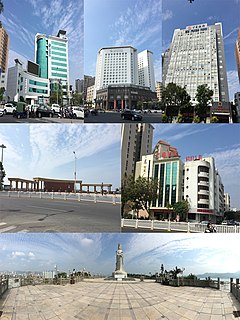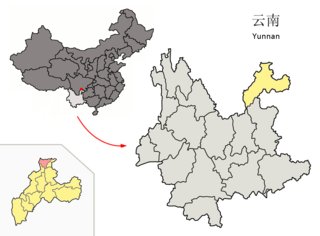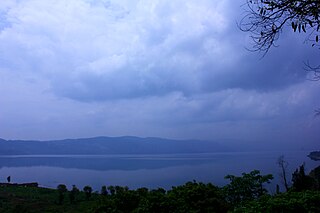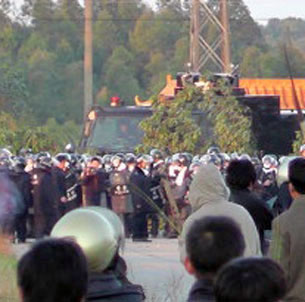Related Research Articles

Yunnan, is a landlocked province in the southwest of the People's Republic of China. The province spans approximately 394,000 km2 (152,000 sq mi) and has a population of 48.3 million. The capital of the province is Kunming. The province borders the Chinese provinces of Guizhou, Sichuan, autonomous regions of Guangxi, and Tibet as well as Southeast Asian countries: Vietnam, Laos, and Myanmar. Yunnan is China's fourth least developed province based on disposable income per capita in 2014.

Lufeng, alternately romanized as Lukfung, is a county-level city in the southeast of Guangdong province, administered as a part of the prefecture-level city of Shanwei. It lies on the mainland on coast of the South China Sea east of Hong Kong.

Shanwei, or Swabue is a prefecture-level city in eastern Guangdong province, People's Republic of China. It borders Jieyang to the east, Meizhou and Heyuan to the north, Huizhou to the west, and looks out to the South China Sea to the south. It lies approximately 120 kilometres (75 mi) east of Shenzhen and the locals speak the Haifeng dialect.
The Dongzhou protests refers to a series of protests that took place for seven months until December 2005 in Dongzhou (东洲), a subdistrict in Shanwei prefecture, Guangdong Province, China. The protests were organized in opposition to government plans to partially infill the bay and build a new power plant. It resulted in the shooting deaths of several residents in the night of 6 December 2005 by People's Armed Police. The death toll is unknown, with different sources mentioning anywhere from three to several dozen deaths. The protests resumed in November 2006.
Anti-environmentalism is a movement that favors loose environmental regulation in favor of economic benefits and opposes strict environmental regulation aimed at preserving nature and the planet. Anti-environmentalists seek to persuade the public that environmental policy impacts society negatively. The movement's goals include to counter the effects of environmental ideology and movements, to diminish public concern about the environment and to persuade politicians against increasing environmental regulations.
Environmental policy in China is set by the National People's Congress and managed by the Ministry of Environmental Protection of the People's Republic of China. Under the Ministry of Environmental Protection of the People's Republic of China, the Department of Policies, Laws, and Regulations is in charge of establishing and strengthening basic laws and policies such as environmental laws, administrative policies and economical regulations. It is also responsible for the development of national environmental protection policy and macro strategy.

Suijiang County is a county in the northeast of Yunnan province, China, bordering Sichuan province across the Jinsha River to the north and west. It is under the administration of the prefecture-level city of Zhaotong.

Yangzonghai Lake is located between Yiliang County, Chenggong District and Chengjiang County, 45 kilometers east of Kunming City in Yunnan Province, China. About 30,000 people rely on the Lake as their drinking water. Yangzonghai Lake is noted for its underwater springs and is one of several scenic areas in Yunnan province, which is known for its biodiversity. The lake is a popular resort destination for people living in the nearby provincial capital of Kunming, which itself borders Dianchi Lake, one of China's biggest freshwater lakes but also one of its most polluted.
The 2009 Chinese lead poisoning scandal occurred in the Shaanxi province of China when pollution from a lead plant poisoned children in the surrounding area. Over 850 were affected. Villagers have accused the local and central governments of covering up the scandal.
In spite of restrictions on freedom of association, particularly in the decades since the death of Mao Zedong in 1976, there have been incidents of protest and dissent in China. Among the most notable of these were the 1959 Tibetan uprising against Chinese Communist Party (CCP) rule, the 1989 Tiananmen Square protests, which were put down with brutal military force, the 25 April 1999 demonstration by 10,000 Falun Gong practitioners at Zhongnanhai, and the 2022 protests against COVID-19 lockdowns. Protesters and dissidents in China espouse a wide variety of grievances, including corruption, forced evictions, unpaid wages, human rights abuses, environmental degradation, ethnic protests, petitioning for religious freedom and civil liberties, protests against one-party rule, as well as nationalist protests against foreign countries.

The Wukan protests, also known as the Siege of Wukan, was an anti-corruption protest that began in September 2011, and escalated in December 2011 with the expulsion of officials by villagers, the siege of the town by police, and subsequent détente in the village of Wukan, in the east of Guangdong province. The villagers rose up again in June 2016, but were again suppressed. The most recent rounds of clashes were in September 2016, when the former village leader Lin Zulian was sentenced to jail. The clashes were suppressed.

The 2011 Haimen protest of December 2011 occurred in the Chinese town of Haimen, Guangdong. The protests, which drew thousands of participants, were met with detentions and tear gassing by authorities.
Forced eviction in the People's Republic of China refers to the practice of involuntary land requisitions from the citizenry, typically in order to make room for development projects. In some instances, government authorities work with private developers to seize land from villagers, with compensation below the market price. In many cases, they are also offered alternative housing instead of or on top of monetary compensation. Forced evictions are particularly common in rural areas, and are a major source of unrest and public protest. By some estimates, up to 65 percent of the 180,000 annual mass conflicts in China stem from grievances over forced evictions. Some citizens who resist or protest the evictions have reportedly been subjected to harassment, beatings, or detention.
The Shifang protest was a large-scale environmental protest in the southwestern Chinese city of Shifang, Sichuan province, against a copper plant that residents feared posed environmental and public health risks. The protests spanned 1–3 July 2012, and drew thousands of participants. Police were dispatched to break up the demonstrations, and reportedly shot tear gas and stun grenades into the crowd. Chinese authorities said some protesters has stormed a government building and smashed vehicles. Images and video of the protest circulated on the microblogs and social networking websites throughout China, some showing the protesters—many of them students—badly beaten. The protests ended late on 3 July when the local government announced that it had terminated construction of the metals plant and released all but six protesters who had been taken into custody.
Large-scale incidents of civil disobedience in the People's Republic of China are described by the Chinese government as "mass incidents".
The Banshkhali power plant movement was a 2016 protest movement against a Bangladeshi-Chinese consortium's acquisition of agricultural lands, graveyards and homes to build a coal-based power plant in the Banshkhali Upazila of Chittagong, Bangladesh. Clashes between protesters and police officers killed four or five people. According to the protesters, four more people went missing after the clash with police.

The China PX protest is a series of public demonstrations against the presence of para-xylene (PX) chemical factories in several Chinese cities, including Xiamen, Dalian, Ningbo, Kunming and Maoming among them.
The anti-incinerator movement in China refers to the series of environmental protests that have occurred in opposition to China's numerous planned and operating industrial waste incinerators. The construction of these waste-to-energy facilities, which has prompted the ensuing protest movement, operates as part of China's ongoing efforts to restructure its waste disposal system in regard to its status as the largest producer of municipal solid waste worldwide since 2004. Described by some as being a new type of NIMBY protest, the roots of the anti-incinerator movement can be traced back to the early 1990s, following the introduction of China's first generation of incinerator plants. The movement, however, began in earnest with the benchmark 2006 Liulitun protest taking place in Beijing.
The 2005 Huashui protest took place in Huashui (画水) Town, Dongyang (东阳) County, Zhejiang Province (浙江省) in March and April 2005. The Huashui protest began as opposition to pollution from the Zhuxi Chemical Industrial Park (竹溪工业园), which had been affecting villages in the area since its construction in 2001. After the Dongyang County leadership intervened by sending in officials and police officers to disperse the protesters in what is known as the “April 10th Incident,” the protest developed to oppose the local government's repression, too.
Zheng Yanxiong is a Chinese politician currently serving as director of the Office for Safeguarding National Security of the CPG in the HKSAR. Zheng is known for controversial statements denouncing foreign media reporting on the Wukan protests in Shanwei in 2011, and for the crackdown of renewed protests in Shanwei in 2016.
References
- 1 2 "云南绥江村民不满征地安置堵路踩踏公安局长_雅虎资讯". News.cn.yahoo.com. 2011-03-31. Archived from the original on 2011-04-04. Retrieved 2011-04-04.
- ↑ Hoffman, Samantha. "Escalating Land Protests in Yunnan". China Policy Institute: Analysis. Retrieved 24 April 2017.
- ↑ "Police Disperse Power Plant Protest in China". CNN. Retrieved 4 May 2017.
- ↑ "Timeline of NIMBY Protests". The China Story. Retrieved 4 May 2017.
- ↑ Patience, Martin. "China's Wukan Village Stand Up for Land Rights". BBC, China. Retrieved 24 May 2017.
- ↑ "Congressional Executive Commission on China". United States Congressional Executive (First Edition). October 10, 2011.
- 1 2 3 South China morning post. "SCMP." 2,000 battle police in Yunnan. Retrieved on 2011-04-03.